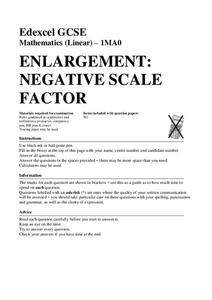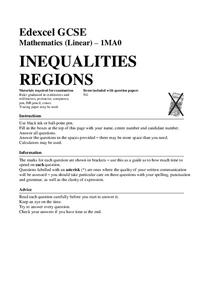National Institute of Open Schooling
Ionic Equilibrium
Scientific studies show the older we get, the more acidic we become. The activity extensively teaches high schoolers about acids and bases. By the end of the 14th installment of 36, they can define and explain three concepts of...
National Institute of Open Schooling
Chemical Equilibrium
Le Chatelier's interest in thermodynamics and building materials such as cement and plaster led to the Le Chatelier Principle in 1884. Activity 13 in a series of 36 extensively explores chemical equilibrium. Learners read about...
National Institute of Open Schooling
Spontaneity of Chemical Reactions
Do spontaneous reactions really occur? Activity 12 in a series of 36 focuses on spontaneity of chemical reactions. Learners read about, discuss, and answer questions pertaining to entropy, explain the third law of thermodynamics, explore...
National Institute of Open Schooling
Colloids
Classes explore colloids through readings and questions in lesson 10 in a series of 36. They learn everything from methods of preparation and properties to how to classify colloids. They finish the lesson by seeing how to apply...
National Institute of Open Schooling
Periodic Table and Atomic Properties
An in-depth lesson, the fourth activity in a series of 36, begins with teaching how the periodic table's arrangement came to its current design. Using this knowledge, pupils then move on to analyze the arrangement of elements to their...
National Institute of Open Schooling
Atomic Structure
Learners explain historical findings such as Rutherford and Bohr's contributions, explain wave particle duality, and formulate Heinsenberg's uncertainty principle. They also draw s, p, and d orbitals, explain more historical findings,...
National Institute of Open Schooling
Mole Concept
Learners explore atomic measurement in the first activity in a series of 36. Through readings, activities, and questions, classes review standard SI units, learn about Avogadro's constant, and use it to help them calculate moles. They...
Read Works
City Autumn
Glimpse a beautiful moment through poetry with a reading comprehension activity. As sixth graders read through "City Autumn" by Joseph Moncure March, they answer ten questions about the setting, mood, vocabulary, and punctuation of the...
Ancient Order of Hibernians
Who Was Saint Patrick?
Scholars discover who Saint Patrick was with help from a brief informational text followed by a series of challenge worksheets designed to boost reading comprehension and vocabulary. Class members complete a graphic organizer, take a...
Read Works
Trading Pumpkins
Can you imagine a pumpkin patch without pumpkins? Learners read how Tammy's family solves their problem in a cooperative way, followed by a set of 10 reading comprehension questions.
Mathed Up!
Negative Scale Factor
Class members investigate the effect of a negative scale factor dilation on coordinate shapes as they watch a short video that shows an example of a geometric figure undergoing a dilation with a negative scale factor. Learners then try a...
Mathed Up!
Upper and Lower Bounds
Investigate how rounding affects values. Individuals watch a video about how to find the highest and lowest possible numbers that result in a given value when rounded to a certain place value. They finish by completing a worksheet of...
Mathed Up!
Fractional and Negative Indices
Explore how to deal with fractional and negative exponents. Scholars watch a video reviewing fractional, zero, and negative exponents. After the video, they test their skills by completing a worksheet covering the concepts.
Mathed Up!
Inequalities Regions
Discover how to solve systems of inequalities by graphing. An informative video shows pupils how to determine the solution set after graphing each inequality of a system. To finish, a worksheet gives them a chance to practice this skill.
Mathed Up!
Solving Quadratics by Factorising
Young mathematicians view a video on solving quadratic equations by factoring. They use this skill to complete a worksheet of practice problems — a great way to gauge understanding!
Mathed Up!
Standard Form
Be sure your young mathematicians can work with scientific notation. Scholars first watch a video to review scientific notation. They then complete a instructional activity requiring conversions and operations with scientific notation.
Illustrative Mathematics
Foxes and Rabbits 3
Model periodic populations. Here, in the context of foxes and rabbits, pupils look at graphs of the populations of these animals in a national park over a span of 24 months. Groups analyze the graphs and determine trigonometric functions...
Illustrative Mathematics
Identifying Quadratic Functions (Vertex Form)
Pupils calculate the equation of a quadratic in vertex form from a specific graph and determine an equation that would fit the description of a parabola. The final question determines the individuals' understanding of the signs of the...
Illustrative Mathematics
Medieval Archer
Class members determine the distance a video game character must move to shoot an arrow over a castle wall. Players determine the new equation to enter to represent the trajectory of the arrow and find all the distances the character can...
Illustrative Mathematics
Sum and Difference Angle Formulas
Need practice deriving trigonometric angle formulas? With this worksheet, pupils derive the sum and difference formulas for cosine and tangent and the difference formula for sine. Scholars use the sine sum formula and other known...
National Institute of Open Schooling
Chemical Bonding
Name is Bond, covalent bond. Through readings and answering questions, classes explore the different types of chemical bonds, their characteristics, valence shell electron pair repulsion theory, and atomic orbitals.
National Institute of Open Schooling
Chemical Arithmetics
Substances with the same empirical and molecular formula must be differentiated by their structural formula. Part two in a series of 36 has pupils using chemical formulas to calculate how much of a compound is present in a given...
Macmillan Education
Celebrations: St Patrick’s Day
Celebrate St. Patrick's Day with a couple of fun English language exercises. After first activating students' prior knowledge about Ireland and Irish culture during a class discussion, learners work in pairs or small groups to complete a...
DLTK
Writing Limericks
Scholars are lucky to stretch their poetry writing muscles with a worksheet that challenges them to compose two limericks—one about a boy and the other about a dog.

























